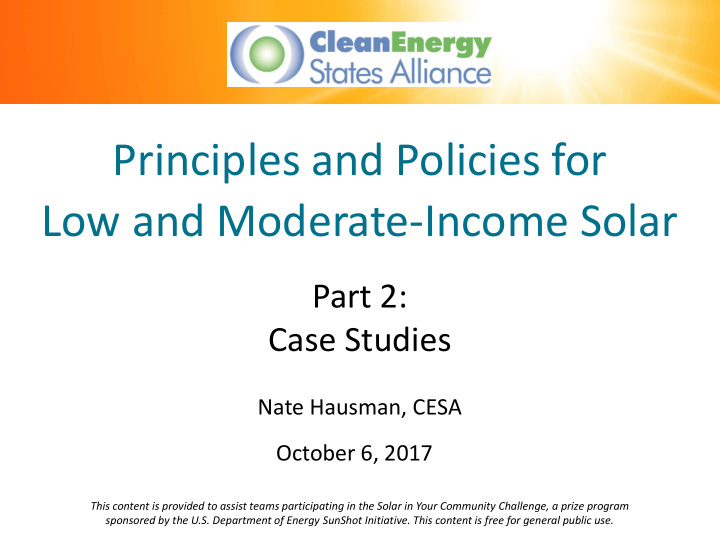



Principles and Policies for Low and Moderate-Income Solar Part 2: Case Studies Nate Hausman, CESA October 6, 2017 This content is provided to assist teams participating in the Solar in Your Community Challenge, a prize program sponsored by the U.S. Department of Energy SunShot Initiative. This content is free for general public use.
Learning Objectives 1. To be familiar with several examples of low- and moderate-income (LMI) solar programs. 2. To learn about different LMI solar programmatic structures — funding sources, stakeholders, program scales and other variables. 2
LMI I Solar Program Case Studies • California’s Single -Family Affordable Solar Homes (SASH) Program • The Fruit Belt Neighborhood Solar Partnership • Alpine Bank’s Community Solar Project Model 3
California’s Single Family Affordable Homes (S (SASH) Program • Geographic Scale: Statewide (PG&E, SCE, and SDG&E service territories) • Program Budget: $54 million (combined with SASH 1.0, the total program budget is $162.34 million) • Solar Capacity: 15 MW • Program Type: Direct Incentive Rebate to low- income single-family home owners • Program Manager: GRID Alternatives 4
Program Basics • Provides rebates of $3 per watt for California families with a household income of less than 80 percent AMI. • Administered by the nonprofit solar company GRID Alternatives. • Incorporates job training. • Serves as a referral service for efficiency improvements. • Approximately 7,000 PV systems installed under the program to date. 5
Fruit Belt Neighborhood Solar Partnership • Geographic Scale: Neighborhood (~ 36 city blocks) in Buffalo, NY • Program Budget: $3.7 Million • Solar Capacity: 500 kW • Program Type: Ratepayer-funded demonstration project to test grid efficiency of concentrating rooftop solar installations in an underserved neighborhood served by a common substation. • Program Manager: National Grid (utility) in partnership with the Buffalo Niagara Medical Campus (nonprofit) 6
Program Basics The neighborhood: • Directly adjoins the Buffalo Niagara Medical Campus. • Served by a common substation. • Average household income is less than half of Buffalo’s area median income. The program tests two hypotheses: 1. That providing solar offsets to LMI neighborhood residents will increase solar adoption, provide energy cost relief, and provide financial supports to the utility for accounts in arrears. 2. That concentrating distributed solar resources within a boundary served by a common substation will deliver measurable grid efficiency benefits. 7
Alpine Bank’s Community Solar Project • Geographic Scale: A 25-kW block of community solar capacity in the Breckenridge Ullr Community Solar Array • Program Budget: Part of an approximately $900,000 investment in five different community solar arrays. • Solar Capacity: 25 kW • Program Type: Volume-discounted community solar investment and donation to an agency that administers bill crediting for low-income residents. • Program Manager: Alpine Bank in partnership with Clean Energy Collective and Family & Intercultural Resource Center (FIRC) 8
Program Basics • Clean Energy Collective, a community solar developer, was statutorily required to allocate 5 percent of each community solar garden’s output to low-income customers. • Alpine Bank, an employee-owned bank with a commitment to renewable energy, was already planning to buy community solar capacity from Clean Energy Collective for its own use. • Alpine Bank agreed to additionally buy the 5 percent of the Breckenridge Ullr Community Solar Array that had to be allocated to low-income customers to help Clean Energy Collective meet its requirement and the bank received a volume discount for its purchase . • Alpine Bank donated the additional panels to the Family & Intercultural Resource Center (FIRC), a nonprofit agency which offers low-income services, and FIRC in turn allocates the net metering credits to low-income households on a rotating basis . 9
Contact In Information Nate Hausman Project Director, CESA nate@cleanegroup.org www.cesa.org 10
Thank you for attending our webinar Questions? Contact: Diana Chace Program Associate, CESA diana@cleanegroup.org Visit CESA’s Solar In Your Community Challenge webpage for more info and resources: www.cesa.org/projects/sustainable-solar/solar-in-your-community-challenge-webinar-series Find us online: www.cesa.org facebook.com/cleanenergystates @CESA_news on Twitter
About This Webinar Series This webinar series is divided into two four-part webinars. Principles and Policies for Low and Principles and Policies for Low and Moderate Income Solar, Part 1 Moderate-Income Solar, Part 2 Friday, October 6, 2017 Friday, November 17, 2017 1. Opportunities and Challenges 1. Presenting solar information to LMI 2. Case Studies consumers 3. Financing Options 2. Engaging LMI communities 4. Direct Incentives 3. Solar+storage for LMI communities 4. Community solar for LMI customers Webinar recordings and registration forms are available on CESA’s website at: www.cesa.org/projects/sustainable-solar/solar-in-your-community-challenge-webinar-series
Principles and Policies for Low and Moderate-Income Solar, Part 2 Friday, November 17, 12-2pm ET Topics to be covered: • Presenting solar information to LMI consumers • Engaging LMI communities • Solar+storage for LMI communities • Community solar for LMI customers Sign up at: http://bit.ly/CESA-Webinar-11-17 Virtual Office Hours The instructors will be available for one-on-one consultations with Challenge participants after the webinars, through virtual office hours . To schedule a consultation, contact Diana Chace at diana@cleanegroup.org
Recommend
More recommend